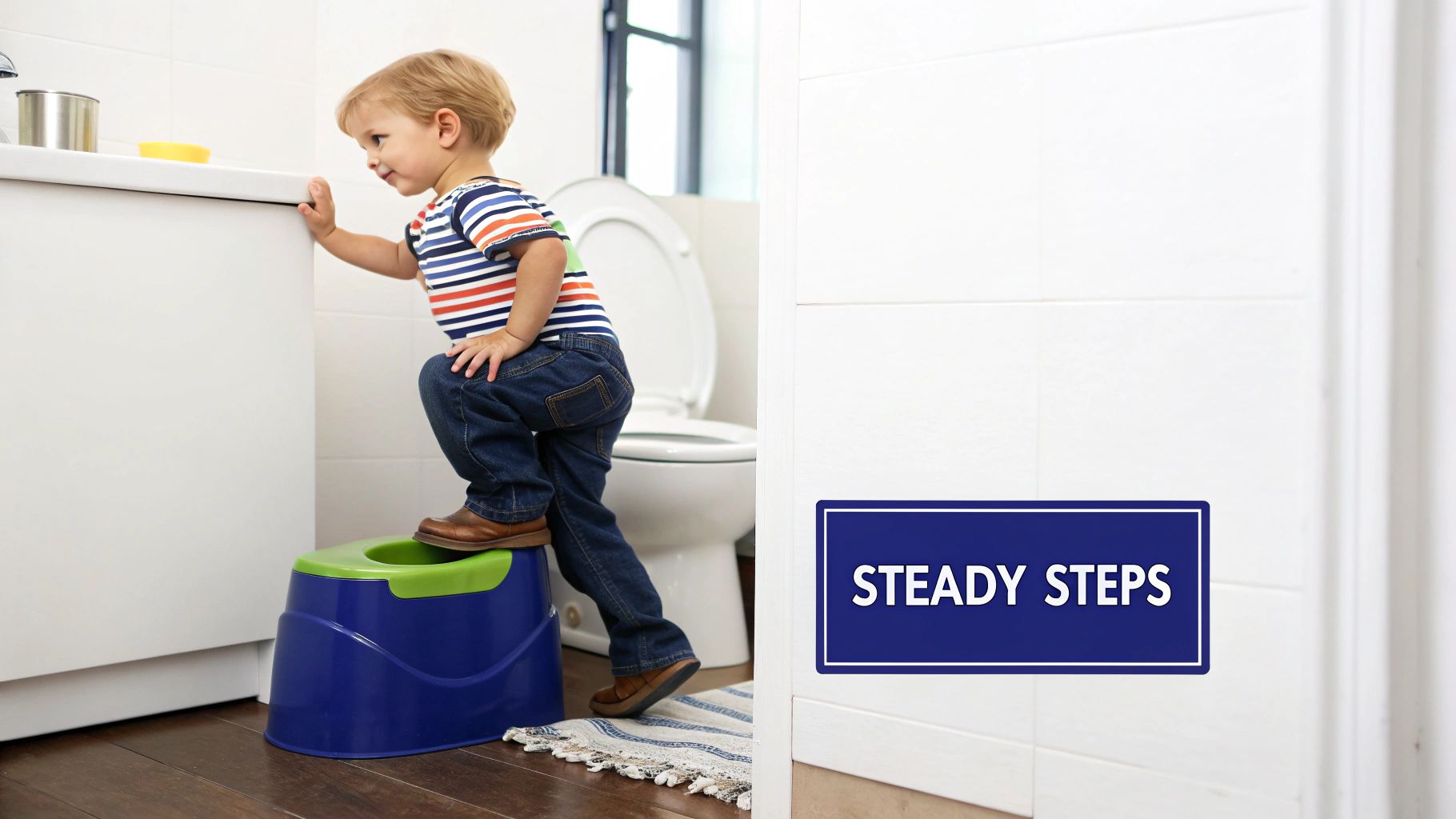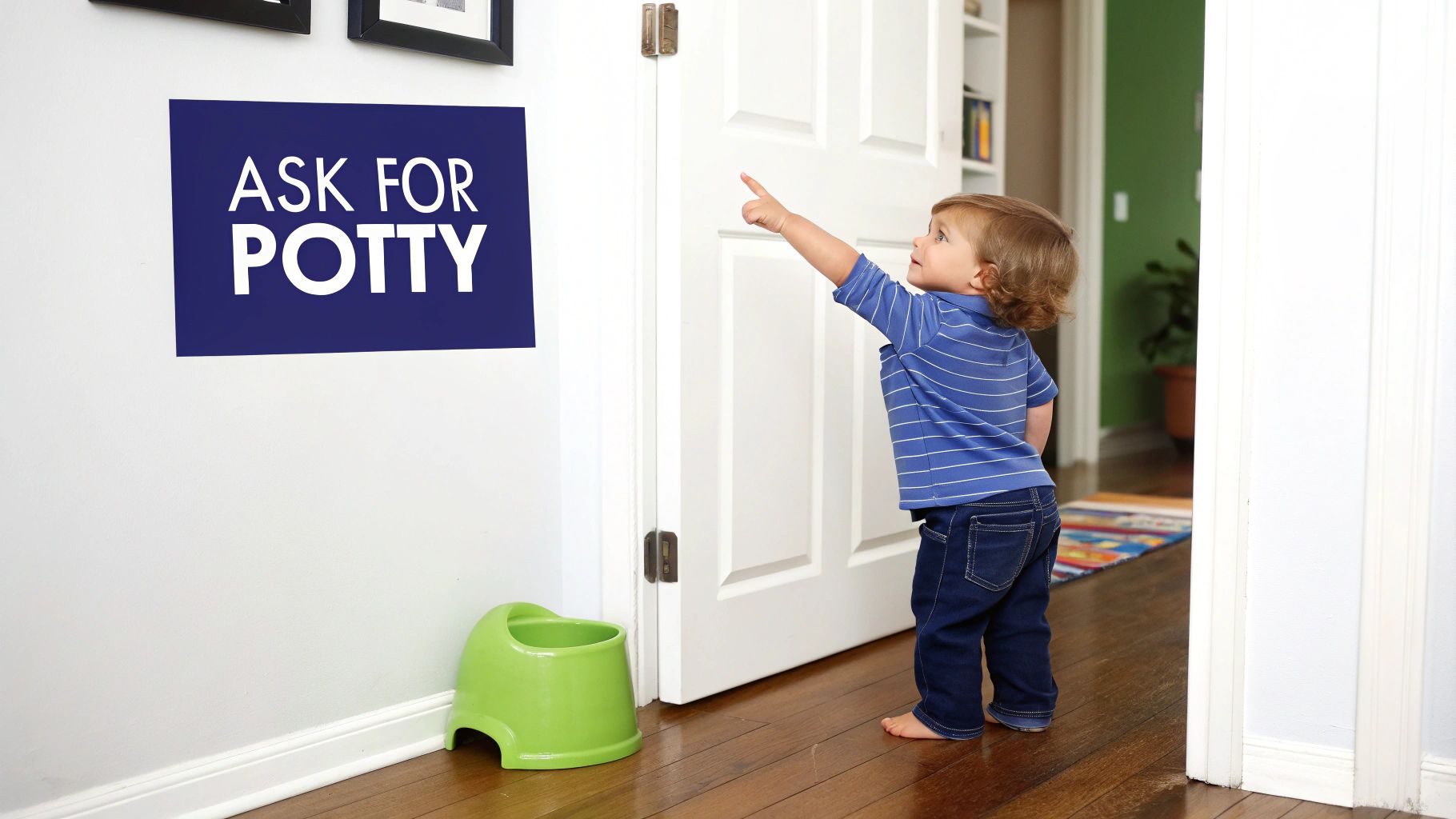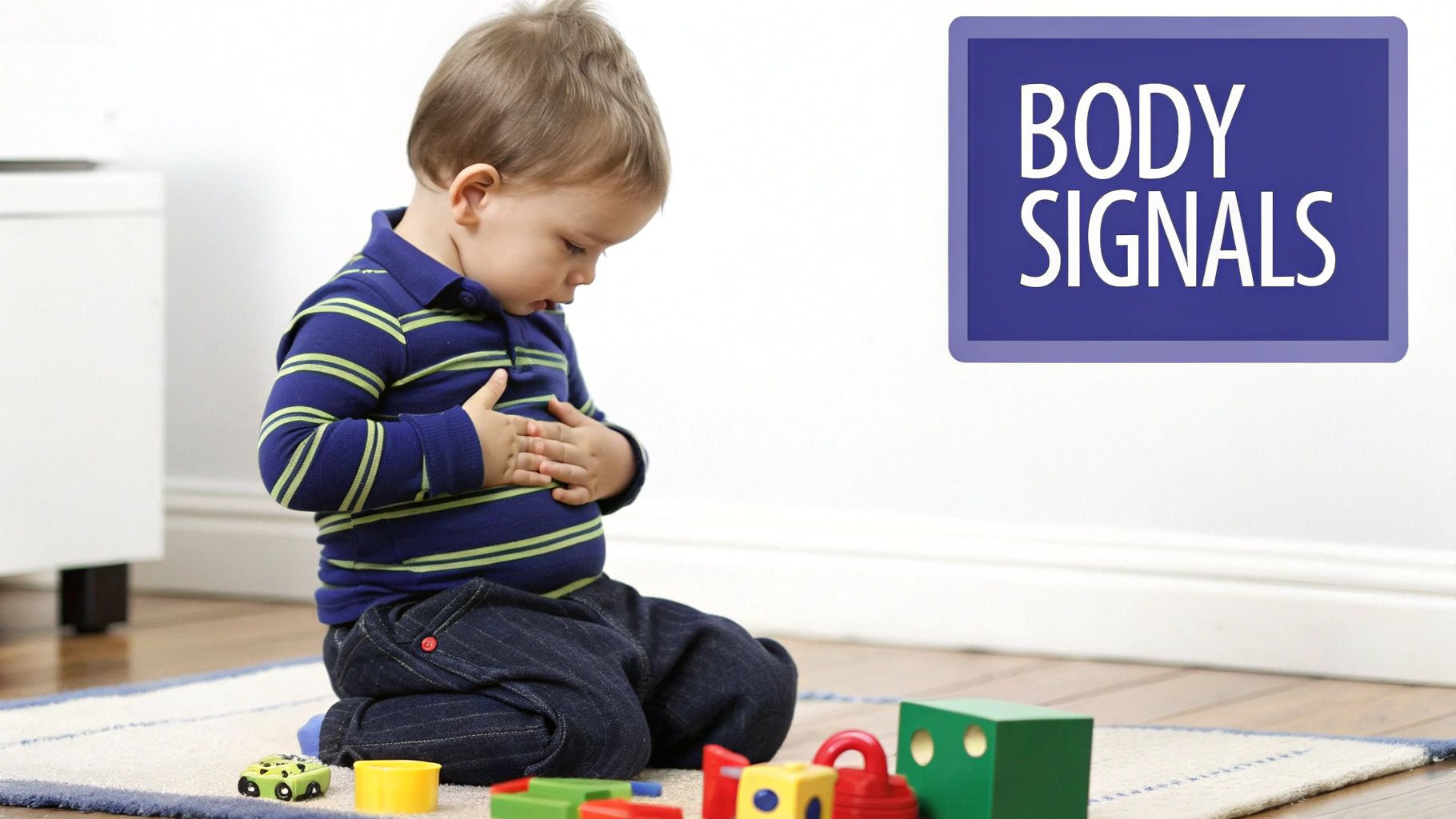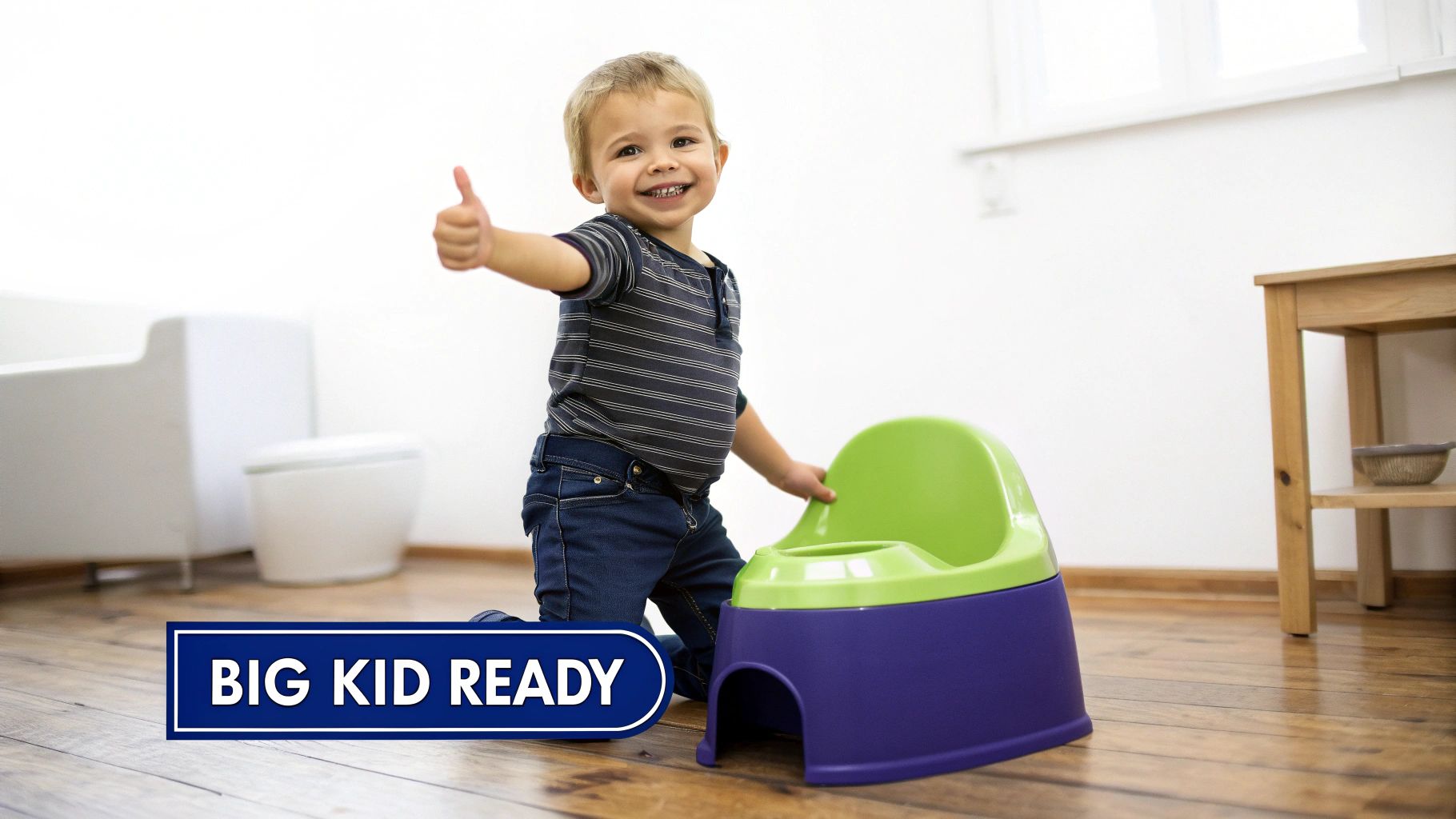The journey from diapers to the potty is a major milestone for every toddler and parent. But how do you know when it's the right time to start? Rushing the process can lead to frustration and setbacks, while waiting too long might miss a crucial window of opportunity. This comprehensive potty training readiness checklist is designed to remove the guesswork. We'll explore the 8 essential signs-spanning physical abilities, communication skills, and emotional maturity-that signal your child is truly prepared.
By understanding these key indicators, you can approach this new chapter with confidence, transforming what can be a stressful transition into a positive and empowering experience for your little one. This guide provides clear, actionable insights to help you recognize when your toddler is ready to begin their potty training journey successfully. Let’s dive into the clear signals your toddler is sending you.
1. Physical Readiness and Motor Skills
Before a child can master using the toilet, they must first master their own body. Physical readiness is a foundational element of any successful potty training readiness checklist because it ensures your toddler has the necessary gross and fine motor skills for independent toileting. This goes beyond simply being able to walk; it involves coordination, balance, and strength.

When a child can confidently walk to the potty, sit down without toppling over, and maintain their posture, they feel more secure and in control. This physical capability is a direct prerequisite for the cognitive and emotional steps that follow. Without it, the process can feel frustrating and overwhelming for them.
Key Physical Milestones to Watch For
Observe your child's everyday movements to gauge their readiness. You're looking for consistent, independent actions that show they have developed core strength and coordination.
- Stable Mobility: Your child can walk steadily from one room to another without stumbling.
- Sitting and Standing: They can lower themselves onto a small chair or potty and stand up again without assistance.
- Clothing Management: They show an ability to pull down and pull up their own elastic-waist pants. This is a crucial fine motor skill for independence.
- Climbing and Squatting: You may notice them successfully climbing onto a step stool or squatting down during play, which mimics the posture needed for elimination.
Actionable Tip: Turn dressing and undressing into a game. Cheer them on as they practice pulling their pants up and down before bath time or when changing into pajamas. This builds both skill and confidence.
2. Staying Dry for Extended Periods
A key biological signal on any potty training readiness checklist is your child's ability to stay dry for longer stretches. When you notice their diaper is still dry after a two-hour nap or a long car ride, it's a clear sign that their bladder muscles are strengthening and their nervous system is maturing. This developing physical control is a non-negotiable prerequisite for successful potty training.

This change indicates that their bladder capacity is increasing, allowing them to hold urine for more significant periods rather than eliminating small amounts constantly. Recognizing this milestone, a concept championed by experts like Dr. T. Berry Brazelton, allows you to align your training efforts with your child's natural developmental rhythm, preventing frustration. Understanding when to start potty training on bennybradleys.com is largely about identifying these physical cues.
Key Dryness Milestones to Watch For
Pay attention to diaper patterns throughout the day to spot this emerging readiness. You're looking for consistent dry spells that signal a shift from involuntary reflexes to budding control.
- Naptime Dryness: Your child regularly wakes up from naps (lasting 1.5-2 hours) with a dry or only slightly damp diaper.
- Longer Intervals: You notice the time between necessary diaper changes extends to two hours or more during waking periods.
- Predictable Timing: Their diapers are consistently dry after specific activities, like a trip to the store or an outing to the park.
- Fewer Diapers Used: You find you are using noticeably fewer diapers per day than you were a month or two ago.
Actionable Tip: Start a simple log to track when your child's diaper is wet or dry. This helps you identify their natural potty rhythm and lets you time your initial potty trips for when they are most likely to succeed, like right after waking up.
3. Communication and Language Skills
Beyond physical ability, potty training success hinges on a child's capacity to communicate their needs. A key indicator on any potty training readiness checklist is your toddler's ability to signal that they need to go, whether through words, signs, or gestures. This communication bridge allows you to respond proactively, turning potential accidents into successful potty trips.

When a child can connect the internal sensation of needing to urinate or have a bowel movement with an external signal you can understand, they gain agency over the process. This two-way communication reduces frustration for both parent and child, creating a more positive and collaborative learning environment. For a deeper dive into fostering these skills, you can learn more about effective potty training communication strategies.
Key Communication Milestones to Watch For
Listen and watch for how your child expresses their physical states and follows directions. These verbal and non-verbal cues show they are developing the cognitive links necessary for training.
- Verbal Cues: They use words like "potty," "pee-pee," or "poo-poo" to name bathroom functions. They may also tell you after they have gone in their diaper.
- Following Instructions: Your child can understand and follow simple, two-step directions such as, "Let's go to the potty and then wash our hands."
- Non-Verbal Signals: They point to their diaper, grunt, squat, or go to a quiet corner when they feel the urge to go.
- Expressing Discomfort: They show they dislike the feeling of a wet or dirty diaper by pulling at it or saying "yucky" or "dirty."
Actionable Tip: Introduce potty-specific vocabulary early and consistently. Read books about using the potty together, and use the same words ("potty," "wash hands") every time you go to the bathroom to reinforce their meaning.
4. Independence in Daily Activities
A child's growing desire for autonomy is a powerful signal for potty training readiness. When toddlers begin insisting on doing things "by myself," it shows they are developing the self-help skills and internal motivation needed to leave diapers behind. This sign of independence is a crucial part of any potty training readiness checklist, as it indicates a shift from being cared for to wanting to take charge of their own body and tasks.

This drive for independence often appears in everyday routines long before it connects to toileting. A child who wants to feed themselves, put on their own shoes, or help put away toys is demonstrating the cognitive and emotional development that underpins successful potty training. Harnessing this natural desire makes the process feel like their idea, not a chore.
Key Signs of Growing Independence
Look for small but significant moments where your child asserts their desire to be a "big kid." These actions show they are ready for more responsibility.
- Self-Dressing: They insist on putting on their own shoes or attempting to pull on their pants, even if they struggle.
- Routine Participation: The child actively tries to brush their own teeth, wash their hands, or climb into their car seat without help.
- Following Instructions: They can follow simple, two-step commands, such as "pick up your toy and put it in the box."
- Frustration with Help: They may show frustration or push your hands away when you try to help with a task they are determined to complete alone.
Actionable Tip: Frame using the potty as another exciting "big kid" activity. Say things like, "You did such a great job putting on your shirt! Soon you'll be using the big potty, too." This connects their existing accomplishments to the new skill.
5. Awareness of Bodily Functions
One of the most significant cognitive leaps in the potty training readiness checklist is a child's awareness of their own bodily functions. This mental connection between the feeling of needing to go and the act of urination or a bowel movement is the cornerstone of successful training. When your toddler starts signaling that something is happening in their diaper, it shows their brain is beginning to interpret their body’s cues.
This awareness is a crucial prerequisite for learning to use the toilet. Until a child can recognize the sensation before or during elimination, they won't be able to communicate their need to use the potty in time. Observing these signs confirms they are moving from involuntary reflexes to conscious control.
Key Awareness Milestones to Watch For
Pay attention to subtle changes in your child’s behavior that indicate they are connecting physical feelings with the results. These signals are your green light that they are becoming ready.
- Pausing or Concentrating: The child stops playing mid-activity, stands still, and might have a concentrated look on their face as they urinate or have a bowel movement.
- Hiding for Privacy: You may notice them going behind a couch, into a corner, or to another room to poop. This is a clear sign they understand what is happening and seek privacy for it.
- Verbal Communication: They might start telling you just before, during, or immediately after they’ve gone. Phrases like “I peeing,” “poopoo,” or pointing to their diaper are common.
- Requesting a Change: The child shows discomfort with a wet or dirty diaper and promptly asks for a change, demonstrating an understanding of cause and effect.
Actionable Tip: When you notice these signs, acknowledge them calmly and positively. Say, “I see you’re pooping right now! That’s great you know your body is working. Soon, we can put that poop in the potty.” This normalizes the conversation and links the action to the toilet.
6. Regular Bowel Movement Schedule
Just as important as physical skills is a child's internal clock. A predictable bowel movement schedule is a powerful indicator on any potty training readiness checklist because it signals that your toddler's digestive system has matured. This regularity transforms potty training from a guessing game into a more strategic and successful endeavor.
When you can anticipate when your child needs to go, you can proactively guide them to the potty, setting them up for a win. This predictability builds their confidence by helping them connect the physical sensation of needing to poop with the act of sitting on the toilet, which is a crucial cognitive leap in the potty training journey.
Key Signs of a Predictable Pattern
Consistency is the goal. A regular schedule doesn't have to be exact to the minute, but a general pattern shows their body is ready.
- Post-Meal Movements: Your child often has a bowel movement shortly after breakfast or dinner.
- Time-of-Day Consistency: They tend to poop around the same time each day, such as during their afternoon quiet time or soon after waking up.
- Recognizable Cues: You notice them showing familiar signs (like grunting or hiding) at predictable intervals.
- Well-Formed Stools: Stools are soft and formed, which indicates good digestive health and makes the process more comfortable for them.
Actionable Tip: Before officially starting, keep a simple log for a week to track your child's bowel movements. Note the time of day and any related activities, like meals. This data will help you schedule potty sits for maximum success.
7. Interest in Bathroom Activities and Imitation
When your toddler suddenly becomes your shadow in the bathroom, it’s a powerful signal of readiness. This newfound curiosity is a key developmental step on any potty training readiness checklist because imitation is one of the primary ways children learn new skills. They see you using the toilet and become motivated to copy that "big kid" behavior.
Harnessing this natural desire to mimic makes potty training feel less like a chore and more like an exciting new activity they get to participate in. When a child wants to be involved, the process becomes a collaborative effort rather than a battle of wills, dramatically increasing your chances of success.
Key Signs of Imitative Interest
Look for these specific behaviors that show your child is paying close attention and is mentally preparing to learn about using the potty.
- Following You: Insists on coming into the bathroom with you and watching what you do.
- Play-Based Learning: Pretends to have their stuffed animals or dolls use a toy potty.
- Toilet Fascination: Shows a strong desire to flush the toilet or wash their hands, even when not using the potty.
- "Big Kid" Aspiration: Asks to wear "big kid underwear" like an older sibling or friend.
- Curious Practice: Sits on their potty, often fully clothed, just to try it out during playtime.
Actionable Tip: Lean into their curiosity by narrating your actions. Say, "Mommy is going to the potty, then I will flush and wash my hands." This demystifies the process. You can also equip them with toy potties and other potty training essentials on bennybradleys.com to encourage role-playing.
8. Emotional Readiness and Cooperation
Beyond physical skills, your child's emotional state is a cornerstone of a successful potty training readiness checklist. This aspect involves their willingness to cooperate, their desire to please, and their ability to handle the inevitable frustrations of learning a new, complex skill. Emotional readiness ensures the process feels like a positive step forward rather than a source of conflict.
When a toddler is emotionally prepared, they are less resistant to new routines and more receptive to your guidance. They can manage minor setbacks without significant meltdowns, turning potty training into a collaborative effort. This cooperation is vital, as pressure or force can quickly lead to power struggles and regression.
Key Emotional Milestones to Watch For
Observe how your child interacts with you and handles daily routines to gauge their emotional preparedness. You are looking for signs of growing independence and a desire to engage in "big kid" activities.
- Cooperative Spirit: They cooperate with routines like getting dressed or having their diaper changed instead of fighting it.
- Desire for Independence: The child shows excitement about growing up and taking on new responsibilities.
- Emotional Regulation: They can transition between activities without major tantrums and handle minor disappointments well.
- Response to Praise: They react positively to encouragement and are motivated by your positive reinforcement.
Actionable Tip: Frame potty training as an exciting "big kid" adventure. Talk about all the cool things big kids get to do, like wearing underwear with their favorite characters. This taps into their natural desire for independence and makes them a willing participant.
Potty Training Readiness: 8-Point Checklist Comparison
| Readiness Indicator | Implementation Complexity 🔄 | Resource Requirements ⚡ | Expected Outcomes 📊 | Ideal Use Cases 💡 | Key Advantages ⭐ |
|---|---|---|---|---|---|
| Physical Readiness and Motor Skills | Moderate | Moderate (supervision, equipment) | Stable walking, coordination, potty access | Children developing gross/fine motor skills | Foundation for independence and safety |
| Staying Dry for Extended Periods | Moderate | Low (tracking diapers, fluids) | Increased bladder control, longer dry periods | Timing potty attempts during dry phases | Predicts potty training success |
| Communication and Language Skills | Moderate | Moderate (time, verbal interaction) | Clear expression of bathroom needs | Children able to understand and follow instructions | Reduces frustration, enhances guidance |
| Independence in Daily Activities | Moderate | Moderate (tools, supervision) | Self-help skills, willingness for potty tasks | Children gaining autonomy in daily routines | Emotional readiness, supports self-confidence |
| Awareness of Bodily Functions | Moderate | Low (observation, encouragement) | Recognition of elimination signals | Children showing physical and neurological awareness | Supports mind-body connection development |
| Regular Bowel Movement Schedule | Low | Low (tracking, diet management) | Predictable toileting times | Children with digestive maturity | Helps establish routine, reduces accidents |
| Interest in Bathroom Activities | Low | Low (toys, books, modeling) | Curiosity and imitation of bathroom habits | Children motivated by social learning | Natural motivation and readiness to learn |
| Emotional Readiness and Cooperation | Moderate | Moderate (patience, timing) | Cooperation, patience, handling setbacks | Children emotionally stable and ready to cooperate | Reduces training conflicts, improves progress |
Bringing It All Together: Your Next Steps on the Potty Path
Navigating the transition from diapers to the potty is a significant milestone, and understanding when your child is truly ready is the foundation for success. This potty training readiness checklist serves as your guide, helping you identify the crucial physical, cognitive, and emotional cues that signal it's time to begin. Remember, this isn't about checking every single box at once. Instead, look for a cluster of these signs to emerge, indicating a holistic readiness.
The journey is unique for every family. One child might show strong communication skills early on, while another might first demonstrate readiness through physical independence, like pulling their pants up and down. The key takeaway is to observe your child as an individual and recognize that their pace is the right pace. Patience and positivity are your most valuable tools. When you see consistent signs like staying dry for longer periods, showing curiosity about the toilet, and communicating their needs, you can feel confident moving forward.
Your Action Plan for Success
Once you've used this potty training readiness checklist and determined the time is right, your role shifts from observer to coach. Here are your next steps:
- Gather Your Gear: Equip your bathroom with a child-friendly potty chair or a toilet seat insert and a sturdy stool. Making the space accessible and safe reduces intimidation.
- Introduce the Concept: Start talking openly about using the toilet. Read fun, encouraging books about the potty and let them see family members using the bathroom.
- Establish a Routine: Begin by encouraging potty sits at key times, such as upon waking, before bath time, and before leaving the house. Consistency builds habit and predictability.
Embracing this process with a supportive and low-pressure attitude transforms it from a daunting task into an empowering adventure. You are not just teaching a practical life skill; you are building your child's confidence, fostering their independence, and strengthening your bond. Celebrate the small victories, offer gentle reminders during setbacks, and trust that you and your child will get there together.
Ready to make potty training a more positive and predictable experience? Explore the innovative potty training watches and other parent-approved tools from Benny Bradley's. Their products are designed to create fun, consistent routines that empower your child on their journey to potty independence. Visit Benny Bradley's to find the perfect tools to support your family.
